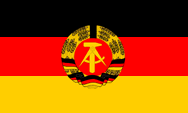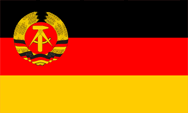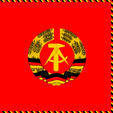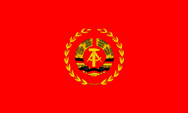


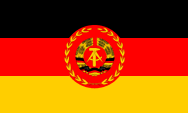
1959–1989,
Official flag of the army (war flag),
ratio = 3:5,
Source: nach/by: Wappen und Flaggen aller Nationen, Corel Draw 4





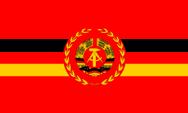
to 1989,
Official flag of the navy (naval flag),
ratio = 3:5,
Source: nach/by: Flaggen und Wappen, Corel Draw 4



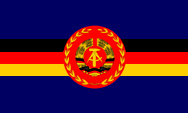
to 1989,
Flag for aux ships,
ratio = 3:5,
Source: nach/by: Flaggen und Wappen, Corel Draw 4



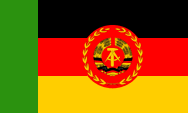
to 1989,
Official flag of the border patrol,
ratio = 3:5,
Source: nach/by:
Flags of the World, Corel Draw 4



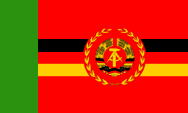
to 1989,
Naval flag of the border patrol,
ratio = 3:5,
Source: nach/by:
Flags of the World, Corel Draw 4





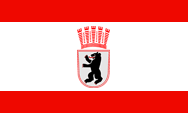
since 1934,
Flag of Great Berlin, in East Berlin used only until 1956,
ratio = 3:5,
Source: nach/by:
Flags of the World, Corel Draw 4, Jürgen Kaltschmitt



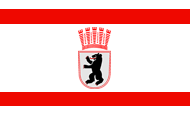
since 1934,
Official flag of Great Berlin, flag of East Berlin since 1956,
ratio = 3:5,
Source: nach/by:
Flags of the World, Corel Draw 4, Jürgen Kaltschmitt



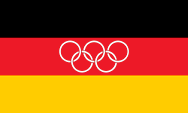
1960–1968,
Olympia flag,
ratio = 3:5,
Source: nach/by:
Flags of the World, Corel Draw 4



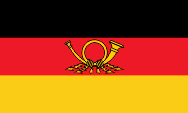
1955–1973,
Postal flag,
ratio = 3:5,
Source: nach/by:
Jürgen Kaltschmitt




Read here:

Informations, history and facts about the theme → "Postal flags".

The later flag of the GDR was already adoped in the Soviet Occupation Zone on 18th of May in 1948. It showed then only three horizontal stripes in black, red and gold, so without a coat of arms. It should stand for the whole Germany and be a renewal of the german flag from 1848 and 1919.
In the constitution of the GDR from the 7th of Oct. in 1949 is written about that in article 2: "The colors of the German Democratic Rep. are Black, Red, Gold."
In the Western Occupation Zone the same flag was officially introduced on the 23rd of May in 1949. It should as well stand for the whole Germany and be a renewal of the german flag from 1848 and 1919. At the foundation of the FRG it became took over on the 7th of September in 1949 as flag of the FRG.
After the foundation of the GDR on the 7th of October in 1949 was the in the Soviet Occupation Zone on 18th of May in 1948 adoped flag likewise maintained. In this way the GDR in the Soviet Occupation Zone had the same flag like the FRG in the Western Occupation Zone.
With the looming ultimate separation of the both german states must have been created a better differentiatable symbolism. Because of this was introduced on 12th of January in 1950 an emblem of the GDR. Per law of the 1st of October in 1959 the emblem was placed in the middle of the flag.
From 1959 to 1973 the GDR had her own merchant flag. It had the coat of arms of the GDR in the upper canton. But more than once the flag was "only accidental by the Sea-Winds" several times swaddled around the flag-cord, the emblem of the GDR was not to recognize, and the flag was not to differentiate from the flag of the Federal Republic of Germany. Some Misters did not like this .... The flags of the GDR were abolished with the reunification of Germany on the 3rd of october in 1990.
Between 1956 and 1964, the GDR and the FRG had a joint Olympic team, and between 1960 and 1968 even a joint Olympic flag. In Sydney (1956) the joint Olympic team marched in, still under the black-red-golden flag. In Rome (1960) and Tokyo (1964), the black-red-golden flag was used with white Olympic rings in the middle. In Mexico City (1968) there were already two separate German teams who marched separately into the Olympic Stadium, but each of the two teams marched in under the black-red-golden flag with the white Olympic rings in the middle.
A special form of flags are the banners, long-stretched flags, which are frequently fixed on a narrow crossbar. Informations about German
banners and banner flags ← click here
Source:
Die Welt der Flaggen,
Jürgen Kaltschmitt

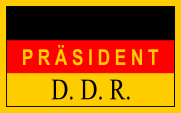
1949-1950,
Standard of the president,
ratio = 3:5,
Source: nach/by:
Wikipedia (D)



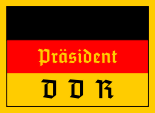
1950-1951,
Standard of the president,
Rekonstruktion,
ratio = 5:8,
Source: nach/by:
Wikipedia (D)



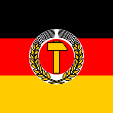
1951-1953,
Standard of the president,
Rekonstruktion,
ratio = 1:1,
Source: nach/by:
Wikipedia (D)



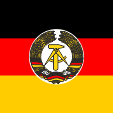
1953-1955,
Standard of the president,
Rekonstruktion,
ratio = 1:1,
Source: nach/by:
Wikipedia (D)



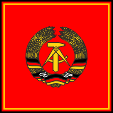
1955-1960,
Standard of the president,
ratio = 1:1,
Source: nach/by:
Wikipedia (D)




The GDR had a standard of the president, too. First, since 1949, it was a golden bordered black-red-golden flag with the inscriptions "President" and "DDR" whose font was changed in 1950. The original of the first standard is now to see in the German Historical Museum in Berlin. In 1951 was introduced a square flag with three stripes in black, red and gold, and in the middle was placed the emblem of the GDR. In 1953, the emblem was changed. In 1955 was introduced a single coloured red standard with a black, red and golded border, which was maintained until the death of president Wilhelm Pieck in 1960. Thereafter, the presidency as head of state was abolished, and became replaced by the chairman of the state council, who used a similar standard.
Source: nach/by: Wikipedia (D),
Jürgen Kaltschmitt

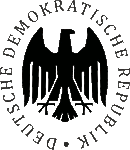
first draft for the coat of arms of GDR,
Source:
Iris Benner: Wettlauf um das Adlerwappen. In: museumsmagazin, H. 3/2008,
Jürgen Kaltschmitt
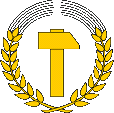
1950–1953,
Emblem of GDR,
Source:
Wikipedia (D),
Jürgen Kaltschmitt
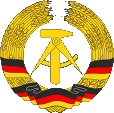
1953–1955,
Emblem of GDR,
Source:
Wikipedia (D),
Corel Draw 4
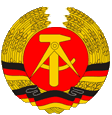
1955–1990,
Emblem of GDR,
Source:
Wikipedia (D),
Corel Draw 4

The first emblem of the GDR was introduced on 12th of January in 1950. It showed an hammer, surrounded by wheat ears. Yet in 1951 the provisional nature of this symbol was emphasized, designated as "emblem", and the term "coat of arms" was officially avoided. In the times before, there were plans to follow the German tradition and to introduce an eagle "looking to the east" as symbol of the state. With the establishment of the FRG, this idea disappeared.
On 28th of May in 1953 was introduced a new emblem - consiting in hammer, circles and ear wreath. The symbols stood for the unity of those who work in industry (hammer), science (circles) and agriculture (ear wreath). On 26th of September in 1955 a red background was added. The emblem was maintained in this form until the end of the GDR. It has only been merely banished from the public from the 31st of May in 1990.
Source:
Die Welt der Flaggen,
Jürgen Kaltschmitt

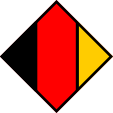
to 1959,
Aircraft Roundel,
Source, by:
Jürgen Kaltschmitt
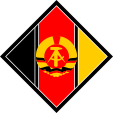
1959–1990,
Aircraft Roundel,
Source, by: Wikipedia (EN)

Position:
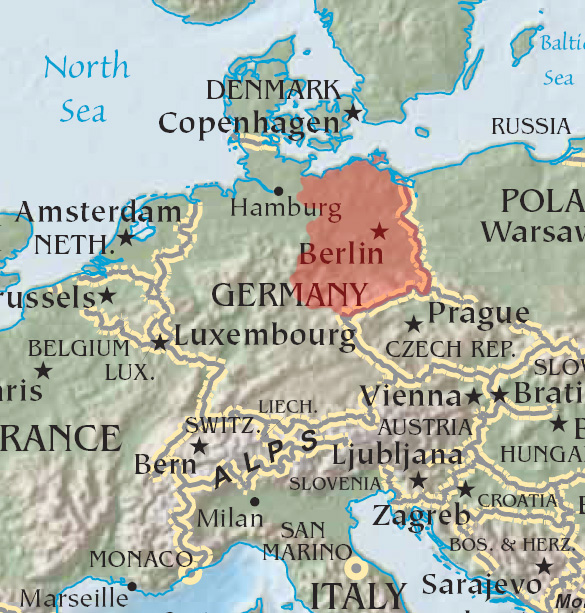
Source: Freeware, University of Texas Libraries, modyfied by: Volker Preuß

Area: 41.827 square miles (1983)
Inhabitants: 16.700.000 (1983), thereof 100.000 Slavic Sorbs
Density of Population: 399 inh./sq.mi.
Capital: Berlin (East Berlin), 1.180.000 inh. (1983)
Amtssprache: German
Currency 1949–1964: German Mark (DM) = 100 Pfennige
Currency 1964–1968: Mark of the German Note Bank (MDN) = 100 Pfennige
Currency 1968–1990: Mark of the GDR (M) = 100 Pfennige
Zeitzone: GMT + 1 h
Source: Länder der Erde, Der Michel

8th of May 1945 · capitulation of the German war-might, Russian occupation of middle Germany, eastern Germany gets subordinated under Polish administration
11th of June 1945 · communists take the political initiative under Soviet protection
1945–1949 · single measures in preparation of a communist seizure of power
7th of October 1949 · foundation of the GDR, communist seizure of power in Soviet initiative
6th of July 1950 · GDR recognizes the enduring Polish occupation of eastern Germany
16th–17th of June 1953 · worker's revolt against communist forceed measures
13th of August 1961 · build of the "Berlin Wall"
Summer 1989 · wave of exit and escape
Autumn 1989 · mass demonstrations, initially for democratization, later for the reunification of Germany
9th of November 1989 · fall of the "Berlin Wall"
1st of July 1990 · currency-, economy - und social-union with the FRG
3rd of October 1990 · annexation of the GDR to FRG

The name "German Democratic Republic", was very contradictory. Here was indeed spoken German, but that state was not German. It was not sovereign and existed under the tutelage of the Soviet Union. This state was also not democratic, because it was a dictatorship, so that even the designation "republic" does not apply. In practice the word monster became oftenly shortened to "GDR" ("DDR"), further had been common "Central Germany, or" East Germany ", or "Soviet Zone".
Source: Volker Preuß


![]()

